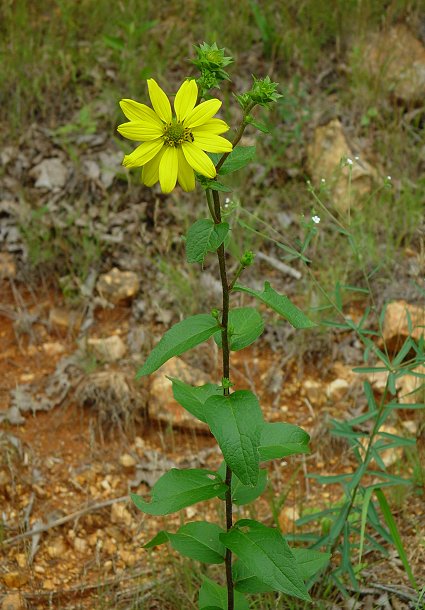Silphium asteriscus L.
Starry Rosinweed

Native
CC = 7
CW = 5
MOC = 18
© DETenaglia
Silphium asteriscus L.Starry Rosinweed | |
 |
Native CC = 7 CW = 5 MOC = 18 |
© DETenaglia |
|
Family - Asteraceae/Heliantheae Habit - Perennial forb with short, stout rhizomes. Stems - Ascending to erect, to 1 m, solitary or appearing clustered, simple to branching near apex, circular in cross-section (often finely many-angled), moderately to densely roughened-hairy (many of the hairs 0.8-2.0 mm long, especially toward the stem tip).
Leaves - Alternate, simple, short petiolate below, sessile above, relatively thin to relatively thick but not leathery, the surfaces moderately to strongly roughened or short-hairy, the hairs often pustular-based. Basal and lowermost stem leaves long-petiolate, the bases slightly expanded and somewhat wrapped around the stem, the blade 12-25 cm long, elliptic to narrowly ovate or lanceolate, unlobed, tapered to a usually sharply pointed tip, tapered at the base, the margins entire or finely to coarsely toothed and usually with minute, spreading to loosely appressed hairs. Stem leaves somewhat reduced toward the tip of the stem, 2-15 cm long, sessile or petiolate, lanceolate or narrowly elliptic to ovate or broadly ovate, angled, tapered, rounded at the base, occasionally clasping the stem, angled or tapered to a sharply pointed tip.
Inflorescences - Terminal clusters or open panicles, rarely of solitary heads, the heads long-stalked to short-stalked or nearly sessile.
Heads - Radiate. Involucral bracts 12-26, 10-20 mm long, elliptic to ovate, spreading to somewhat recurved at the sharply pointed tip, the surfaces moderately to densely hairy or roughened with often pustular-based, more or less spreading hairs, often also with stalked and/or sessile glands, the margins fringed with short, spreading to loosely ascending hairs. Receptacle 1.0-2.2 cm in diameter.
Flowers - Ray florets 13-17, fertile, the corolla 15-30 mm long, narrowly elliptic to narrowly oblong, with small notch at apex, glabrous, yellow. Disc florets staminate, 40 to numerous, the corolla 5-6 mm long, slightly shorter than or extending slightly beyond the tips of the chaffy bracts, 5-lobed, yellow, glabrous, the style exserted and undivided. Pappus absent.
Fruits - Achenes compressed, winged, 5-15 mm long, the surfaces glabrous or with fine, curled hairs at the tip, the angles with narrow to broad, lighter wings, each wing rounded or tapered at the tip, the fruit usually with a shallow, semicircular to broadly U-shaped apical notch. Flowering - May - September. Habitat - Glades, tops of bluffs, sinkholes, and forest openings, pastures, ditches, railroads, and roadsides. Origin - Native to the U.S. Lookalikes - Numerous, particularly including several species of Helianthus, also Heliopsis helianthoides. Other info. - This plant can be found in Ozark counties within the southern quarter of Missouri. Elsewhere its range includes much of the eastern half of the continental U.S., particularly the southeast. Its appearance is similar to numerous other yellow-flowered composites, collectively and affectionately known as "DYCs" (darned yellow composites, the term denoting some frustration with the many, often-confusing lookalikes). It may be differentiated from the others by its alternate leaves, broad involucral bracts, and the combination of fertile ray florets and sterile disk florets, as shown in the diagram above. This last feature serves to differentiate plants in the Silphium genus from the sunflowers (genus Helianthus), which have fertile disks and sterile rays. Most of Missouri's species of Silphium have similar flowering heads but leaves which are totally different from each other. Photographs taken at the Peck Ranch Wildlife Refuge, Carter County, MO., 6-12-03 (DETenaglia); also along Hwy 181 in Douglas County, MO, 7-2-2020, and along Hwy 19 in Shannon County, MO, 6-15-2023 (SRTurner). |